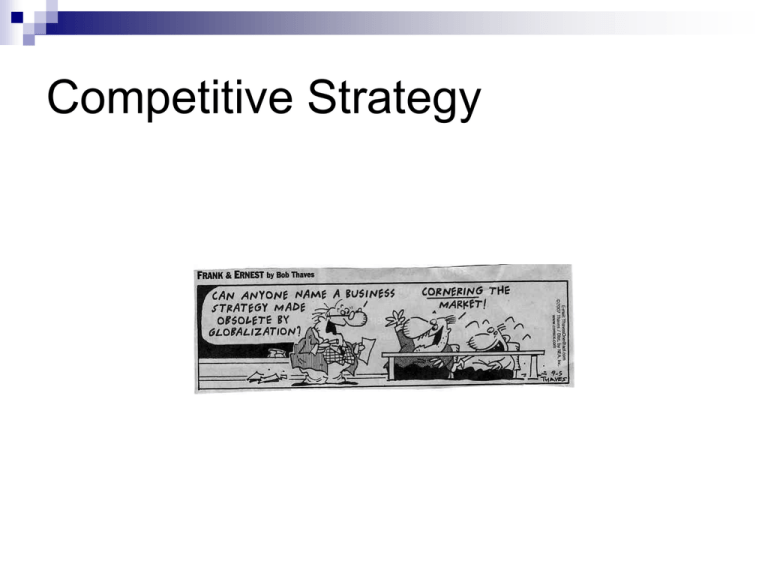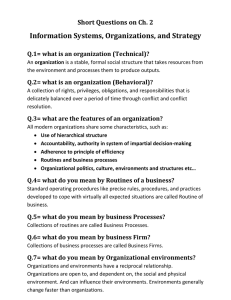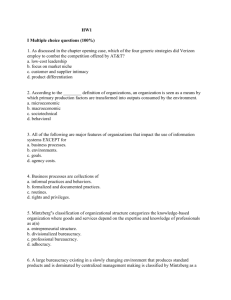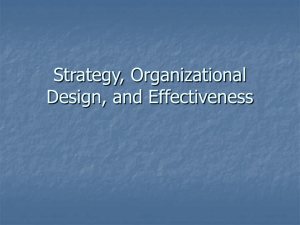Competitive Strategy
advertisement

Competitive Strategy Competitive Strategy A competitive strategy consists of moves to Attract customers Withstand competitive pressures Strengthen an organization’s market position The objective of a competitive strategy is to generate a competitive advantage, increase the loyalty of customers and beat competitors A competitive strategy is narrower in scope than a business strategy Five competitive strategies are Overall low-cost leadership strategy Best cost provider strategy Broad differentiation strategy Focused low-cost strategy Focused differentiation strategy Overall Low-Cost Leadership Strategy Strive to be the overall low-cost provider in an industry How to achieve overall low-cost leadership Scrutinize each cost activity Manage each cost lower year after year Reengineer cost activities to reduce overall costs Cut some cost activities out of the value chain Competitive strengths of a overall low-cost strategy Organization in a better position to compete offensively on price Organization is better able to negotiate with large customers Organization is able to use price as a defense against substitutes Low cost is a significant barrier to entry Organization is more insulated from the power of suppliers When Does an Overall Low-Cost Strategy Work the Best When price competition is a dominant competitive force The product is a “commodity” There are few ways to differentiate the product Most customers have similar needs/requirements Customers incur low switching costs changing sellers Customers are large and have significant bargaining power When Doesn’t a Overall Low-Cost Strategy Work When technological breakthroughs open cost reductions for competitors, negating a low-cost provider’s efficiency advantage Competitors find it relatively easy and inexpensive to imitate the leader’s low cost methods Low-cost leader focuses so much on cost reduction that the organization fails to respond to Changes in customer requirements for quality and service New product developments Reduced customer sensitivity to price Broad Differentiation Strategies Striving to build customer loyalty by differentiating an organization’s products from competitors’ products Keys to success include Finding ways to differentiate to create value for customers that are not easily copied Not spending more to differentiate than the price premium that can be charged A successful differential strategy allows an organization to Set a premium price Increase unit sales Build brand loyalty Broad Differentiation Strategies Where to look for differentiation opportunities Supply chain Research and development Production activities Marketing, sales and service activities Strengths of a Differentiation Strategy Customers develop loyalty to the brand Brand loyalty acts as an entry barrier Organization is better able to fend off threats of substitute products because of brand loyalty Reduces bargaining power of large customers since other brands are less attractive Seller may be in a better position to resist efforts of suppliers to raise prices Pitfalls of a Broad Differentiation Strategy Trying to differentiate on an unimportant product feature that doesn’t result in providing more value to the customer Over differentiating the product such that the product features exceed the customers’ needs Charging a price premium that buyers perceive as too high Ignoring need to signal value Not identifying what customers consider valuable Best-Cost Provider Strategy Striving to give customers more value for the money by combining an emphasis on low cost with an emphasis on upscale differentiation Combines low-cost and differentiation The objective is to create superior value by meeting or beating customer expectation on product attributes and beating their price expectations Keys to success Match close competitors on key product attributes and beat them on cost Expertise at incorporating upscale product attributes at a lower cost than competitors Contain costs by providing customers a better product Advantages of Best-Cost Provider Strategy Competitive advantage comes from matching close competitors on key product attributes and beating them on price Most successful best-cost providers have skills to simultaneously manage costs down and product quality up Best-cost provider can often beat an overall low-cost strategy and a broad differentiation strategy where Customer diversity makes product differentiation the norm Many customers are price and value sensitive Focus Strategies Focus strategy based on low-cost Focus strategy based on differentiation Concentrate on a narrow customer segment beating the competition on lower cost Offering niche customers a product customized to their needs Overall objective of both focus strategies is to do a better job of serving a niche target market than competitors Keys to success Choose a niche were customers have a distinctive preference, unique needs or special requirements Develop a unique ability to serve the needs of a niche target market What Makes a Niche Attractive? Large enough to be profitable Good growth potential Not critical to the success of major competitors Organization has the resources to effectively serve the niche Organization can defend itself against challengers through a superior ability to serve the niche No competitors are focusing on the niche Strengths and Risks of Focus Strategies Strengths Competitors don’t have the motivation to meet specialized needs of the niche Organization’s competitive advantage could be seen as a barrier to entry Organization’s competitive advantage provides an obstacle for substitutes Organization’s ability to meet the needs of customers in the niche can reduce the bargaining power of large niche buyers Risks Broad differentiated competitors may find effective ways to enter the niche Niche customers’ preferences may move toward the product attributes desired by a larger market segment Profitability may be limited if too many competitors enter the niche








